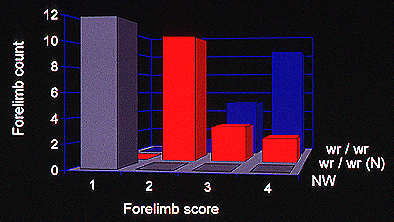 Reduction of lower motor neuron degeneration in wobbler mice by N-acetylcysteine
Reduction of lower motor neuron degeneration in wobbler mice by N-acetylcysteine Reduction of lower motor neuron degeneration in wobbler mice by N-acetylcysteine
Reduction of lower motor neuron degeneration in wobbler mice by N-acetylcysteineJeffrey T. Henderson, Mohammed Javaheri, Susan Kopko and John C. Roder
Samuel Lunenfeld Research Institute, Mount Sinai
Hospital,
Program in Molecular Biology and Cancer, 600
University Ave., Toronto, Ontario M5G-1X5
Figure 5. Treatment with N-acetyl-cysteine greatly reduces losses of forelimb motor function.
 Score of forelimb ambulation at 7 weeks of age: (1) no apparent atrophy, limbs outstreached when suspeneded, continuous grasping at proximal surface, normal inclination of the phalanges;
(2) visible atrophy of limbs, limbs outstreached when suspeneded, continuous grasping at proximal surface, normal inclination of the phalanges;
(3) significant atrophy of limbs, limbs not outstreached when suspeneded, tentative grasping at proximal surface, abnormal (less than or equal to 60') inclination of the phalanges;
(4) severe limb atrophy, limbs held close to body when suspeneded, no grasping at proximal surface, abnormal (greater than or equal to 90') inclination of the phalanges. Forelimbs
were scored seperately for each animal. For the NW and NW(N) -(not shown) groups, n=6, with all animals scoring "1". For wr/wr, wr/wr(N) groups, n=8 animals per group. For each
pair-wise comparison of the treatment groups [wr/wr vs. wr/wr(N), wr/wr vs. NW or NW(N), wr/wr(N) vs. NW or NW(N)], p<0.001.
Score of forelimb ambulation at 7 weeks of age: (1) no apparent atrophy, limbs outstreached when suspeneded, continuous grasping at proximal surface, normal inclination of the phalanges;
(2) visible atrophy of limbs, limbs outstreached when suspeneded, continuous grasping at proximal surface, normal inclination of the phalanges;
(3) significant atrophy of limbs, limbs not outstreached when suspeneded, tentative grasping at proximal surface, abnormal (less than or equal to 60') inclination of the phalanges;
(4) severe limb atrophy, limbs held close to body when suspeneded, no grasping at proximal surface, abnormal (greater than or equal to 90') inclination of the phalanges. Forelimbs
were scored seperately for each animal. For the NW and NW(N) -(not shown) groups, n=6, with all animals scoring "1". For wr/wr, wr/wr(N) groups, n=8 animals per group. For each
pair-wise comparison of the treatment groups [wr/wr vs. wr/wr(N), wr/wr vs. NW or NW(N), wr/wr(N) vs. NW or NW(N)], p<0.001.